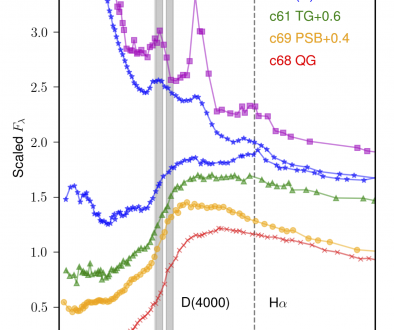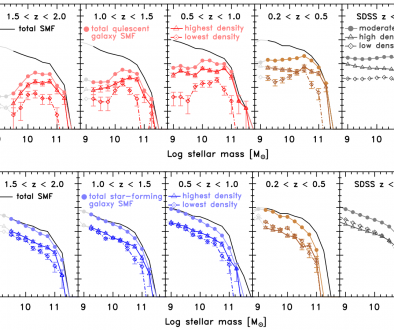Papovich 2015 Summary
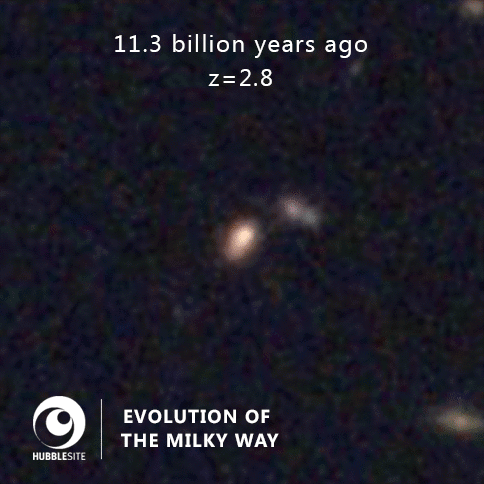 Evolution of M* Galaxies over 11 billion years of cosmic history: Galaxies with stellar masses near M* contain the majority of stellar mass in the local universe, and are therefore of special interest in the study of galaxy evolution. The Milky Way (MW) and Andromeda (M31) both have present-day stellar masses near M*, at 5 x 1010 solar masses (defined here to be MW-mass) and 1011 solar masses (defined to be M31-mass). By studying the evolution galaxies at these masses, we learn about the formation of galaxies that host typical stars at present.
Evolution of M* Galaxies over 11 billion years of cosmic history: Galaxies with stellar masses near M* contain the majority of stellar mass in the local universe, and are therefore of special interest in the study of galaxy evolution. The Milky Way (MW) and Andromeda (M31) both have present-day stellar masses near M*, at 5 x 1010 solar masses (defined here to be MW-mass) and 1011 solar masses (defined to be M31-mass). By studying the evolution galaxies at these masses, we learn about the formation of galaxies that host typical stars at present.
We study the typical progenitors of M* galaxies using ZFOURGE. The depth of these surveys are sensitive to the progenitors of these galaxies out to z ~ 3, spanning more than 80% of cosmic time of the Universe. We use abundance-matching techniques (e.g., Moster et al. 2013, Behroozi et al. 201X ) to identify the main progenitors of these galaxies at higher redshifts.
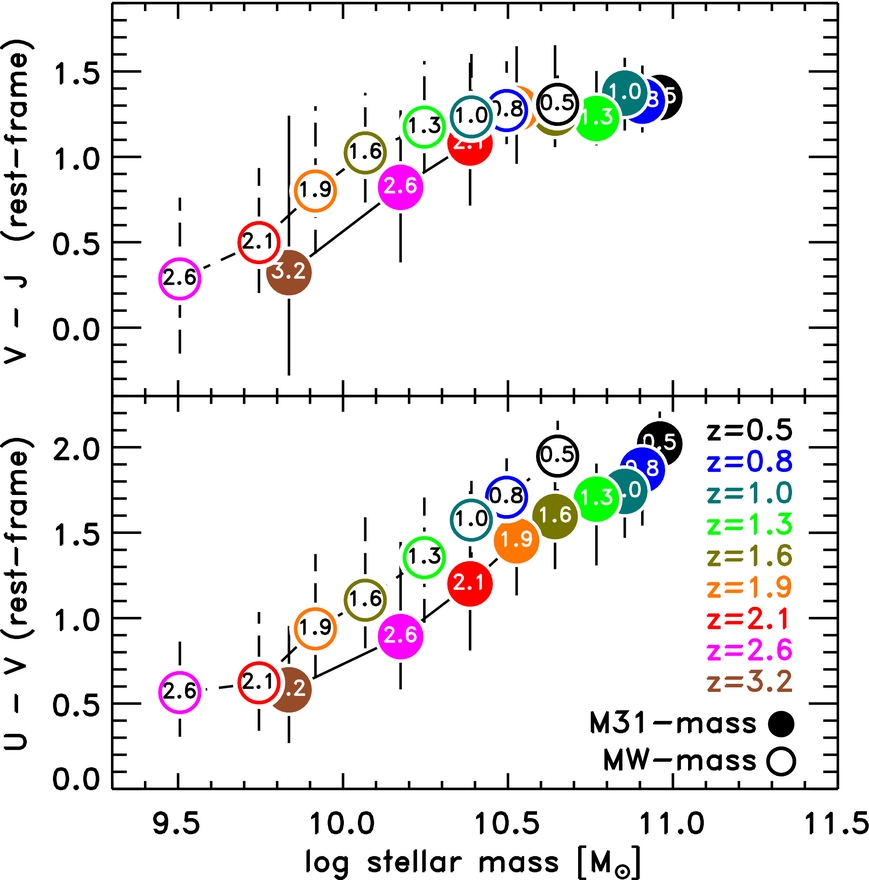 We measure the evolution in the stellar mass, rest-frame colors, morphologies, far-IR luminosities, and star formation rates, combining our deep multiwavelength imaging with near-IR Hubble Space Telescope imaging from Cosmic Near-IR Deep Extragalactic Legacy Survey (CANDELS), and Spitzer and Herschel far-IR imaging from Great Observatories Origins Deep Survey-Herschel and CANDELS-Herschel.
We measure the evolution in the stellar mass, rest-frame colors, morphologies, far-IR luminosities, and star formation rates, combining our deep multiwavelength imaging with near-IR Hubble Space Telescope imaging from Cosmic Near-IR Deep Extragalactic Legacy Survey (CANDELS), and Spitzer and Herschel far-IR imaging from Great Observatories Origins Deep Survey-Herschel and CANDELS-Herschel.
The typical MW-mass and M31-mass progenitors passed through the same evolution stages, evolving from blue, star-forming disk galaxies at the earliest stages to redder dust-obscured IR-luminous galaxies in intermediate stages and to red, more quiescent galaxies at their latest stages. The progenitors of the MW-mass galaxies reached each evolutionary stage at later times (lower redshifts) and with stellar masses that are a factor of two to three lower than the progenitors of the M31-mass galaxies. The process driving this evolution, including the suppression of star formation in present-day M* galaxies, requires an evolving stellar-mass/halo-mass ratio and/or evolving halo-mass threshold for quiescent galaxies.
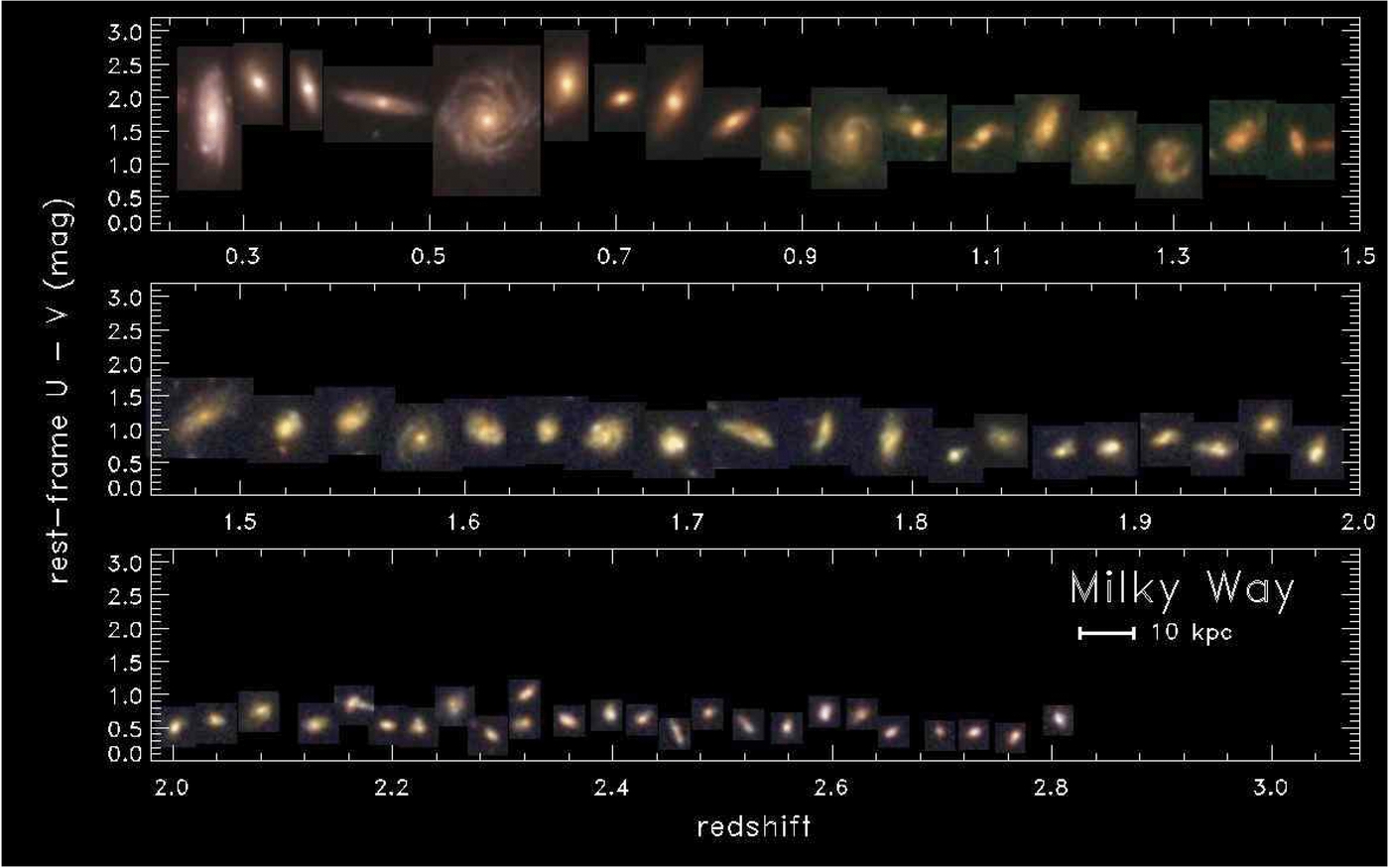 Examples of progenitors of a MW-mass galaxy from z~3 to z=0.5. Each galaxy is selected such that it has the (approximate) median U-V and V-J colors for all progenitors. Each false-color image shows the approximate rest-frame U, B, V-band (blue, green, red, respectively) using CANDELS imaging. The image sizes are scaled to the same fixed physical scale where the inset shows a scale of 10 kpc.
Examples of progenitors of a MW-mass galaxy from z~3 to z=0.5. Each galaxy is selected such that it has the (approximate) median U-V and V-J colors for all progenitors. Each false-color image shows the approximate rest-frame U, B, V-band (blue, green, red, respectively) using CANDELS imaging. The image sizes are scaled to the same fixed physical scale where the inset shows a scale of 10 kpc.
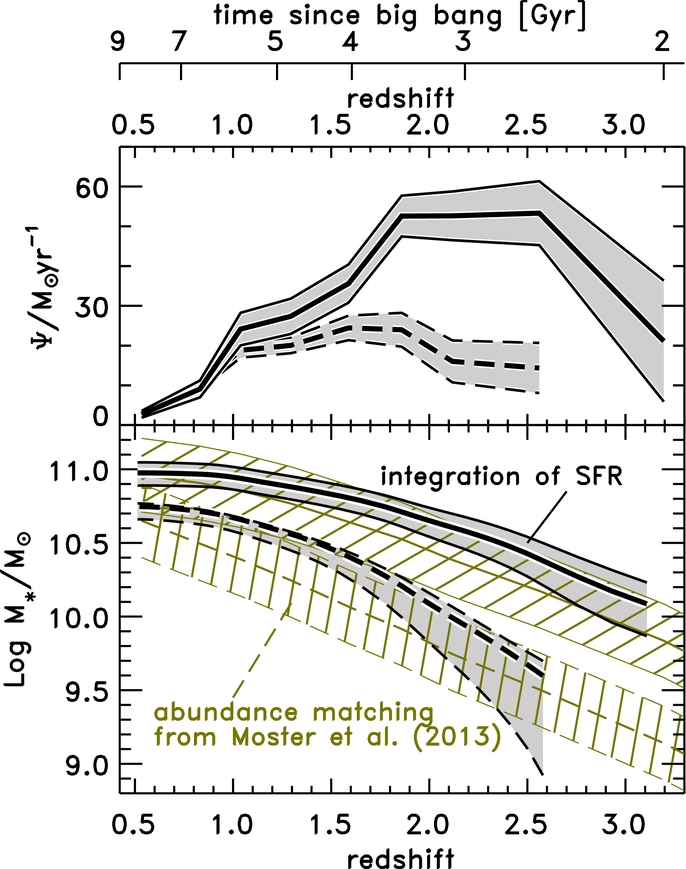 The evolution of the SFR and stellar mass derived from the integrated SFR history. The SFR history is derived from a combination of rest-frame UV and far-IR measurements of the M*-galaxy progenitors. The top panel shows the SFR evolution for the M31-mass (solid lines) and MW-mass (dashed lines) progenitors (the shaded regions show the 68% percentile range). The bottom panel shows the integrated SFR history. The shaded regions correspond to the M31-mass (solid lines) and MW-mass (solid lines) progenitors, as in the top panel. The hashed regions in the bottom panel show the stellar-mass evolution from the abundance matching used to the select the progenitor galaxy samples. Mature morphological features such as bulges appear below a redshift of z=1.5, around the time the galaxies begin their decline in SFR and implied gas-mass (see below).
The evolution of the SFR and stellar mass derived from the integrated SFR history. The SFR history is derived from a combination of rest-frame UV and far-IR measurements of the M*-galaxy progenitors. The top panel shows the SFR evolution for the M31-mass (solid lines) and MW-mass (dashed lines) progenitors (the shaded regions show the 68% percentile range). The bottom panel shows the integrated SFR history. The shaded regions correspond to the M31-mass (solid lines) and MW-mass (solid lines) progenitors, as in the top panel. The hashed regions in the bottom panel show the stellar-mass evolution from the abundance matching used to the select the progenitor galaxy samples. Mature morphological features such as bulges appear below a redshift of z=1.5, around the time the galaxies begin their decline in SFR and implied gas-mass (see below).
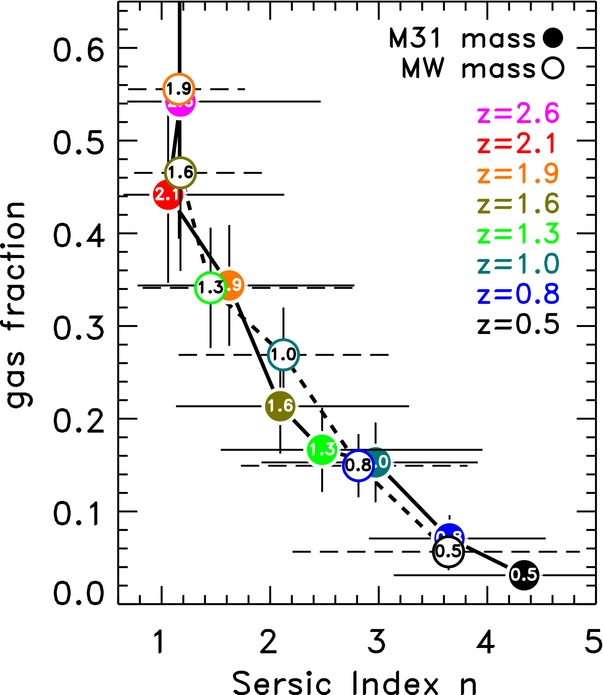 The effective size and SFRs imply that the baryonic cold-gas fractions drop as galaxies evolve from high redshift to z ~ 0 and are strongly anticorrelated with an increase in the Sérsic index. Because our observations are sensitive to only the implied gas fraction evolution, they offer a test: either the gas fractions are as low as implied by the SFR evolution, in which case measurements of the gas masses should show it to be small, or the galaxies contain significant molecular gas, but the gas efficiency is suppressed, perhaps by the presence of mature stellar structures (such as bulges and disks, a process known as “morphological quenching”, see, e.g., Martig et al. 2009). Therefore, the growth of galaxy bulges in M* galaxies corresponds to a rapid decline in the galaxy gas fractions and/or a decrease in the star formation efficiency. Tests of these scenarios will be possible with measurements directly of the gas mass with facilities such as ALMA.
The effective size and SFRs imply that the baryonic cold-gas fractions drop as galaxies evolve from high redshift to z ~ 0 and are strongly anticorrelated with an increase in the Sérsic index. Because our observations are sensitive to only the implied gas fraction evolution, they offer a test: either the gas fractions are as low as implied by the SFR evolution, in which case measurements of the gas masses should show it to be small, or the galaxies contain significant molecular gas, but the gas efficiency is suppressed, perhaps by the presence of mature stellar structures (such as bulges and disks, a process known as “morphological quenching”, see, e.g., Martig et al. 2009). Therefore, the growth of galaxy bulges in M* galaxies corresponds to a rapid decline in the galaxy gas fractions and/or a decrease in the star formation efficiency. Tests of these scenarios will be possible with measurements directly of the gas mass with facilities such as ALMA.
